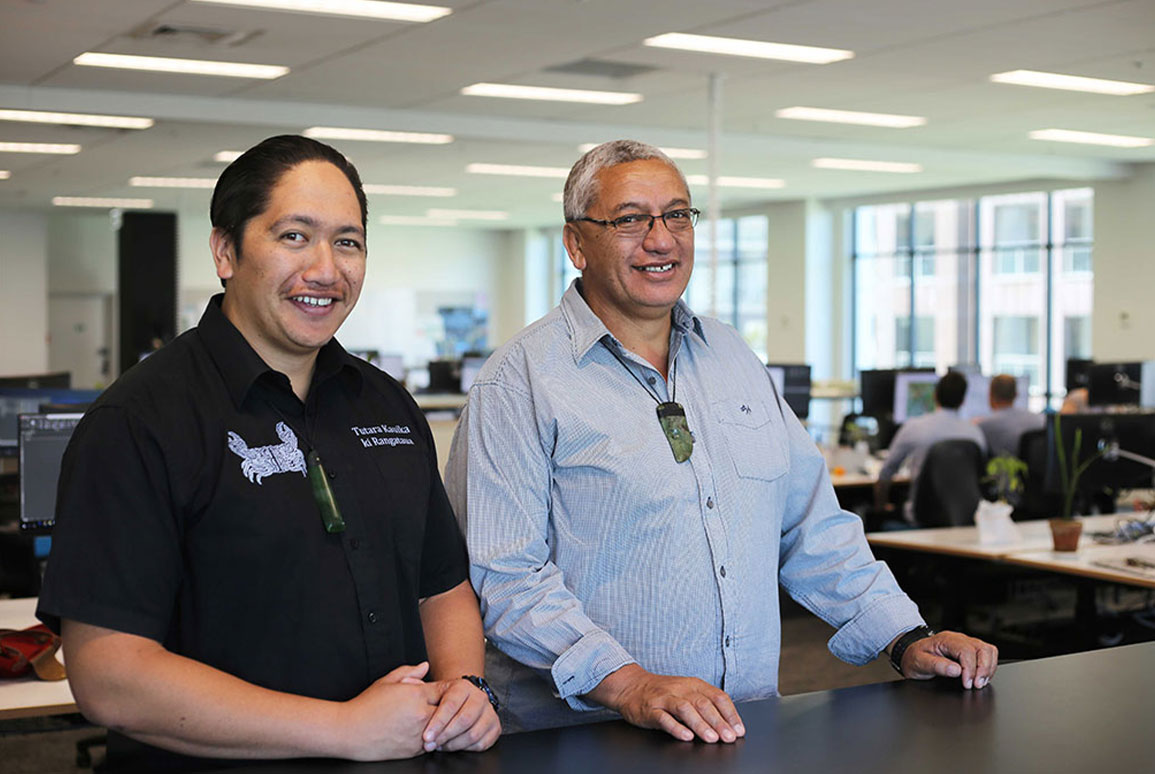Rangitahi Kawe & Te Pio Kawe: two generations
10 December 2018
These meanings resonate with the story of Te Pio Kawe (Kaiarataki - Te Hīhiri / Strategic advisor), his son Rangitahi Kawe (landscape architect), and the evolution of the Te Hīhiri discipline at Boffa Miskell.

Te Pio was contracted to Boffa Miskell’s Tauranga office in 2002 to work on the 50 Year Western Bay of Plenty Sub-Regional Growth Strategy, more commonly called “SmartGrowth”; and became a permanent member of staff in 2003.
He came with a wide range of skills and experience in working on whānau and hapū development projects, specialising in Māori community housing (papakāinga) and hapū management plans.
“It was a time of new beginnings,” Te Pio recalls. “Particularly in relation to the Resource Management area, there was a lot going on: the kaupapa around preparing iwi and hapū management plans, and the process of going from consultation to what we now call engagement.”
The desire to facilitate deeper relationships with mana whenua became an increasing component of Boffa Miskell’s project work in planning, ecology, and design; and more consultants with expertise in mana whenua engagement and mātauranga Māori joined the staff.
“We began to think this should be something more than just cultural advisory,” says Te Pio. “We had a hui in Whakatāne and that’s where Te Hīhiri was born.
“The name comes from the whakatauākī or kōrero that describes the eight stages of growth and development. Te Hīhiri is the third stage: once a seed has been planted, it is nurtured and grows. Te Hīhiri expresses the energy required to break through the earth into ao mārama – the physical world.”
This year Te Pio’s son, Rangitahi, joined Boffa Miskell as a graduate landscape architect.
Rangitahi says his career path started “…when I was young. My nan had me working in the garden; and over the years I had a growing passion for the environment. At school I got into graphic design and technical drawing, and that’s where my interest in the architectural side of the profession began.”
At university, Rangitahi began to consciously incorporate a Māori perspective into his work and his writing.
“Some of my inspiration came from memories with my dad – going fishing or diving with the uncles – and I wanted to use those experiences in my designs. For example, how being welcomed by a pōwhiri can be translated into moving through a public space.”
Rangitahi completed his master’s in landscape architecture from Victoria University of Wellington in 2014. For his thesis he examined Pā sites and identified that having a strong understanding of tikanga Māori and landscape architecture can re-ignite pride of place for Māori and their historic lands.
Rangitahi says, “When I joined, I really felt the aroha and the manaaki around the company. It’s a passion for all the designers here – Māori and non-Māori. Everyone has the desire to infuse their work with influences from the people and the land.”
“From the beginning of Te Hīhiri, the affinity with our ecologists and our planners and our landscape architects has demonstrated that we all have common values,” says Te Pio.
“Everybody wants to swim in clear water and breathe clean air. Everybody wants to feel welcomed when they arrive in a place. Those values are held by everyone, no matter where they’ve come from. The kaitiakitanga that is practiced by us all.
“What we have sought to do with Te Hīhiri is nurture awareness of the energy, the culture, and the creativity we have right here. When we draw on what is home-grown, it gives a sense of belonging to this place and telling the stories of this place. And that’s the challenge for our young minds – and old minds, too: working collectively to find new ways of expressing those values.”

